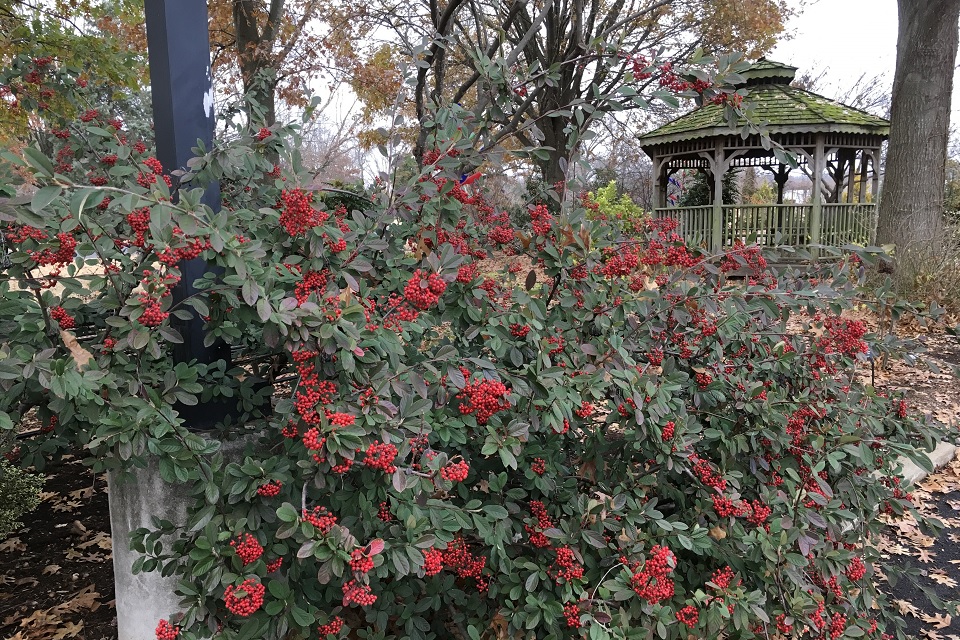
This Graceful Evergreen Adds Winter Interest to Your Landscape
UT Gardens’ January 2018 Plant of the Month: Parney cotoneaster
Submitted by Richard Gibson, Assistant Horticulturist with the UT Gardens, Jackson
This time of year many of us seem to get a little “down in the dumps.” The temperatures are cold, the skies are gloomy, and the garden is taking a rest. We have a tendency to stay cooped up inside and not explore nature. However, if you can bring yourself to venture into the garden, Mother Nature has a lot to offer. You might be surprised at the beauty you come across. Take a look at a public gardens or even a friends for inspiration for you own.
Many plants provide winter interest. Winterberry holly (Ilex verticillata) shows off clusters of cheerful red berries, red-twig dogwood (Cornus sericea, C. sanguinea, and C. alba) reveals bright red stems, and ‘Florida Sunshine’ anise (Illicum parvaflorum) displays vibrant chartreuse foliage. These plants become the center of attention in the winter garden. One particular example I have grown fond of is Cotoneaster lacteus(syn. Cotoneaster parneyi), commonly known as parney cotoneaster. The genus Cotoneaster contains at least 70 species, but unfortunately, their use is limited in much of the United States due to several factors. As Dr. Michael Dirr notes, most species are susceptible to excessive heat, heavy wet soils, lace bug, mites and fireblight, which contribute to their relatively short life in the landscape. With that being said, C. lacteus is truly the exception to the rule – it is virtually pest free.
Parney cotoneaster was introduced to the U.S. in 1930 from western China. Growing to between 6-ft and 8-ft tall and wide in 10 years, its habit is somewhat upright and spreading, with graceful arching branches. This evergreen produces 2-in. to 3-in. clusters of small white flowers in mid May to early June. The flowers give way to beautiful bright red berries that remain on the plant through winter, making this cotoneaster a showstopper. The dark green, deer-resistant foliage provides the perfect backdrop and contrast to the berries. This cotoneaster grows well in full sun to part shade and, while it is very drought tolerant, it performs best in moist, well-drained soils. The specimen at the UT Gardens, Jackson, flourishes beautifully with virtually no care along the parking lot curb near the gazebo. C. lacteus works well in groupings or as a mass planting and is a wonderful addition to any mixed shrub border where additional winter interest is desired.
For a plant that is resistant to drought, diseases and insects as well as very low maintenance, tolerant of a wide range of growing conditions, and interesting in winter, parney cotoneaster is surprisingly underused.
I encourage you to visit the UT Gardens in Jackson or Knoxville to admire parney cotoneaster at its peak at a time when many plants are taking a rest. Consider adding this cotoneaster, and other winter beauties, to your own garden landscape.
The UT Gardens includes plant collections located in Knoxville, Jackson and Crossville. Designated as the official botanical garden for the State of Tennessee, the collections are part of the UT Institute of Agriculture. The Gardens’ mission is to foster appreciation, education and stewardship of plants through garden displays, educational programs and research trials. The Gardens are open during all seasons and free to the public. For more information, see the Gardens website: ag.tennessee.edu/utg.
Contact:
Richard Gibson, Assistant Horticulturist, UT Gardens – Jackson, 731-425-4751